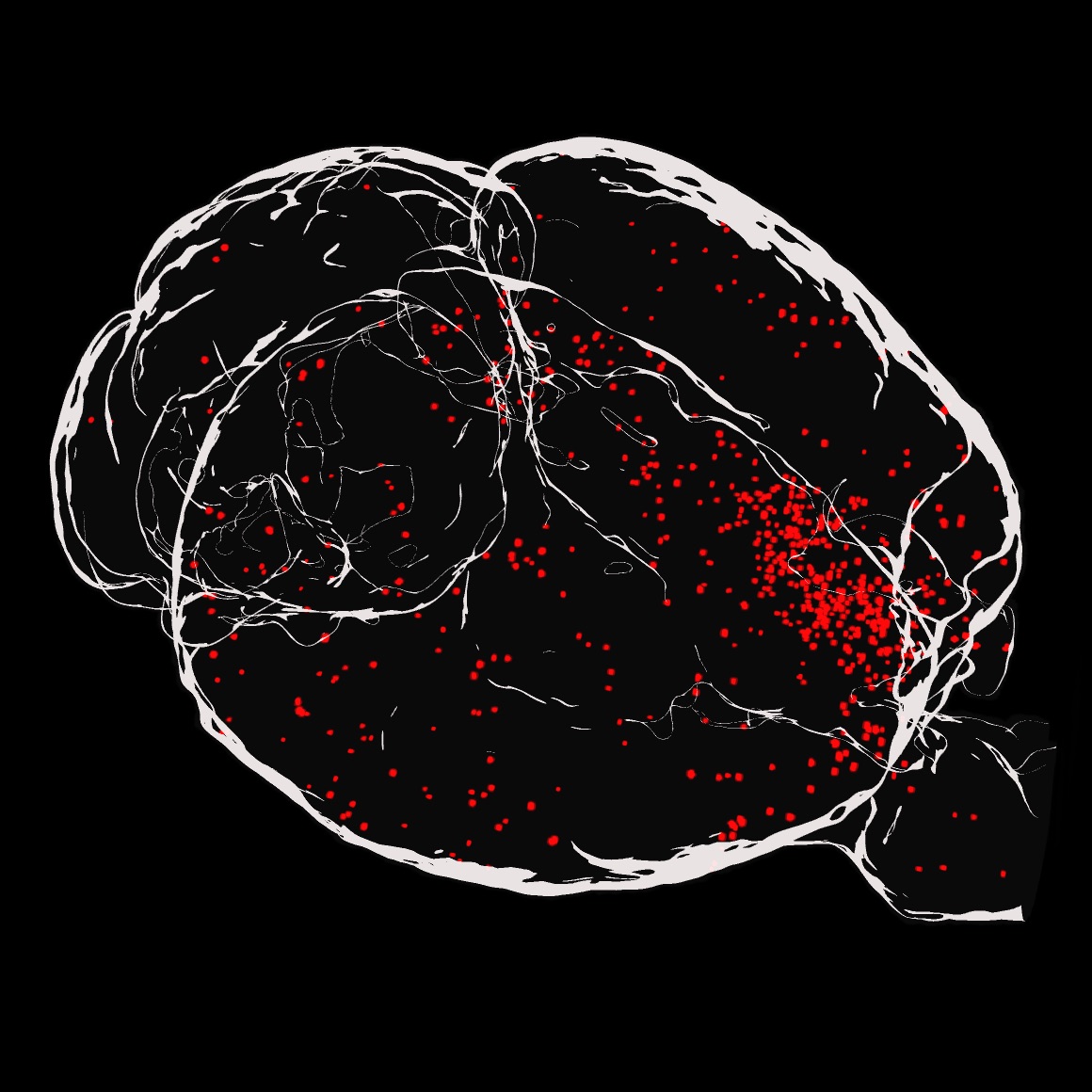Toxoplasmosis rids its host of all fear
Researchers at UNIGE show how the parasite that causes toxoplasmosis colonizes the mouse brain in the form of cysts to such an extent that it drastically modifies the rodent’s behaviour.

3D representation of a brain infected by Toxoplasma gondii and imaged by lighsheet microcopy. © UNIGE
The parasite Toxoplasma gondii infects animals, including humans. Its objective is to reach the intestines of felids, the definitive host in which it reproduces sexually. To do so, the parasite first infects mice and drastically alters their behaviour. The natural fear of mice toward cats is transformed into attraction, making them easy preys. How does the parasite achieve this feat? University of Geneva (UNIGE) researchers, Switzerland, show that the parasite is not limited exclusively to ridding mice of this natural predator fear; it alters their overall behaviour relating to anxiety, stress and curiosity. The more important is the cyst burden in the brain the more uninhibited the mouse becomes. These findings, published in the journal Cell Reports, disprove the myth of a specific alteration of the mouse’s fear of cats, showing instead that the rodent’s general behaviour is altered.
Toxoplasma gondii is a neurotropic parasite that establishes a persistent chronic infection by forming cysts predominantly in the muscle and brain tissues, in all warm-blooded animals including humans. A person can be infected by eating undercooked, infected meat or unwashed fruits and vegetables or by cleaning out a cat’s litter tray. This parasite is opportunistic and responsible for significant morbidity and mortality, especially in immunocompromised individuals in particular those with HIV infection or receiving immunosuppressive or cancer therapy. Toxoplasmosis is also dangerous for a foetus if the mother contracts the infection for the first time during pregnancy. Since the baby cannot be protected by its mother’s immune system, its brain could get infected, causing neurological lesions or early abortion.
A parasite that leads to loss of fear and of inhibition
The parasite that causes toxoplasmosis is transmitted through cats that acts as definitive hosts. In the intestine of felids the parasite is able to undergo sexual reproduction, leading to the shedding of highly infectious oocytes in the faeces. How can it reach the feline? “Carnivorisim is an efficient route of transmission to reach the intestine of the cats,” explains Dominique Soldati-Favre, professor in the Faculty of Medicine’s Department of Microbiology and Molecular Medicine at UNIGE. “This is why the mouse is so ideal!” Several studies revealed that the parasite succeeded in altering mice’s behaviour so markedly that their fear of cats was transformed into attraction, making them easy preys. “We wondered then how Toxoplasma gondii managed to set up such a specific mechanism, namely the exclusive alteration of the fear of cats,” adds Madlaina Boillat, a researcher in the Department of Genetics and Evolution in the Faculty of Sciences at UNIGE.
In the laboratory of Ivan Rodriguez, professor in the same Department of Genetics and Evolution, work is being conducted on the innate behaviours of rodents, such as interactions between prey and predators. In order to determine whether behavioural changes in mice concerned only their reaction to felines, his team first tested the overall anxiety of infected mice, evaluating their basal stress level and their curiosity and then comparing these observations with those of healthy mice. “During this initial evaluation, we immediately noticed a difference in attitude in infected mice—they were more curious and less stressed,” notes Rodriguez. Then, the researchers exposed infected mice and control mice to bobcat urine. “Unlike healthy mice, mice infected by the parasite were all attracted by the smell of the urine, which normally frightens them away,” adds Boillat. The scientists then extended the experiment to other predators of mice such as foxes and, to a greater extent, rats. “We placed a sleeping rat in the cage of the control mice; they immediately exhibited a reaction of panic. By contrast, the infected mice went as far as to walk over the rat!” comments Rodriguez.
These experiments show that, contrary to what is asserted in most of the scientific literature on the topic, it is not only the fear of cats that is inhibited in infected mice, but their behaviour as a whole that is affected. “Our study puts an end to a myth and now enables scientists to investigate the mechanism by which the parasite accomplishes this feat,” points out Pierre-Mehdi Hammoudi, a researcher in Soldati-Favre’s team.
The more cysts, the greater the effect on behaviour
Scientists conducted highly controlled infections which enabled them to determine exactly how many cysts the mouse had developed. “Using the technique of light sheet fluorescence microscopy, we were able to observe the brain with an extreme resolution, and we noticed that the brain as a whole was swarming with cysts, especially the cortex, whereas hypotheses favoured the amygdala, which is associated with the innate fear response,” explains Soldati-Favre. Cysts cause overall inflammation of the brain tissues. “But,” she continues, “behaviourral changes are perceptible when the number of cysts in the mouse brain reaches 200, with a real effect on fear occurring between 500 and 1000 cysts.”
What about humans?
In humans, among whom 30% to 80% of the population is infected, correlations have been observed between toxoplasmosis and neurological alterations, resulting from the indirect effects of cysts caused by inflammation in the brain. “The behaviour of an infected person appears to be slightly altered depending on the degree of inflammation of the brain, but humans remain an accidental host for the parasite, and, barring immunodeficiency, their immune systems manage to control the development of cysts relatively well,” concludes Soldati-Favre. Moreover, the infection appears to predispose patients to certain other neurological diseases such as schizophrenia, Parkinson’s disease or Alzheimer’s.
